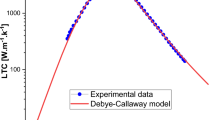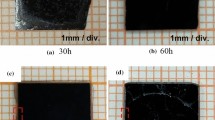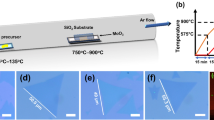Abstract
We present a theoretical examination of the behavior of arsenic atoms in Hg1−xCdxTe for x=0.3, focusing on the thermodynamic conditions that most closely mimic molecular beam epitaxial growth and subsequent annealing steps. We show that, for molecular beam epitaxial growth where tellurium-saturated conditions apply, arsenic incorporates onto the cation sublattice and becomes inactive. A significant fraction of these arsenic atoms are bound to mercury vacancies. We also propose a model of the activation, which involves transfer of the arsenic from the cation to the anion sublattice. The model suggests that activation anneals must be done at high enough temperatures to surmount an activation barrier, and that the phase field from tellurium- to mercury-rich conditions should be traversed slowly enough so that the cation vacancies are not filled before the site transfer can be completed.
Similar content being viewed by others
References
See for example, J.M. Arias, Properties of Narrow Gap Cadmium-Based Compounds, EMIS Datareviews Series No. 10, ed. P. Capper, (INSPEC, 994), p. 30.
S. Sivananthan, P.S. Wijewarnauriya, F. Awariden, H.R. Vydyanath, M. Zandian, D.D. Edwall and J.M. Arias, J. Electron. Mater. 26, 621 (1997).
A.C. Chen, M. Zandian, DD. Edwall, J.M. Arias, P.S. Wijewarnasuriya, S. Sivananthan, M. Berding and A. Sher, J. Electron. Mater. 27, 595 (1998).
H.R. Vydyanath, R.C. Abbott and D.A. Nelson, J. Appl. Phys. 54, 1323 (1983).
H.R. Vydyanath, J.A. Ellsworth and C.M. Devaney, J. Electron. Mater. 16, 13 (1987).
See, for example, P.S. Wijewarnasuriya, S.S. Yoo, J.P. Faurie and S. Sivananthan, J. Electron. Mater. 25, 1300 (1996).
H.R. Vydyanath, Semicond. Sci. Technol. 5, S213 (1990).
H.R. Vydyanath, L.S. Lichtmann, S. Sivanathan, P.S. Wijewarnasuriya and J.P. Faurie, Semicond. Sci. Technol. 24, 625 (1995).
M.A. Berding, A. Sher and M. van Schilfgaarde, Phys. Rev. B 50, 1519 (1994).
M.A. Berding, A. Sher and M. van Schilfgaarde, J. Electron. Mater. 26, 624 (1997).
The tellurium vacancy, tellurium interstitial, and the mercury antisite have been previously identified as minority defects for the purpose of establishment of the majority defect equilibrium and have not been included in the present analysis.
O.K. Andersen, O. Jepsen and D. Glotzel, Highlights of Condensed Matter Theory, ed. F. Bassani et al. (Amsterdam, The Netherlands: North Holland, 1985), p. 59.
U. von Barth and L. Hedin, J. Phys. C 5, 1629 (1972).
Mark van Schilfgaarde, unpublished.
D. Langreth and D. Mehl, Phys. Rev. B 28, 1809 (1983).
M.A. Berding (unpublished).
A. Sher, M. van Schilfgaarde, A.-B. Chen and W. Chen, Phys. Rev. B 36, 4279 (1987).
We have used a one-electron picture of the ionization states, although the formalism is capable of dealing with negative-U centers.
G.L. Hansen, J.L. Schmit and T.N. Casselman, J. Appl. Phys. 53, 7099 (1982).
P. Capper, Properties of Narrow Gap Cadmium-Based Compounds, EMIS Datareviews Series No. 10, ed. P. Capper, (INSPEC, 1994), p. 212.
The conduction band was fit to a linear dispersion to give agreement with experimental intrinsic carrier concentrations. The conduction bands have a more nearly hyperbolic dispersion near the band edge, but we found that for the purpose of fitting the the carrier concentrations, the linear dispersion assumption was adequate.
Expressions for the edge of the existence region for Hg1−xCdxTe were taken from J.C. Brice, Prog. Cryst. Growth Charact. 13, 39 (1986).
M.A. Berding, A. Sher and M. van Schilfgaarde, J. Electron. Mater. 24, 1127 (1995).
Author information
Authors and Affiliations
Rights and permissions
About this article
Cite this article
Berding, M.A., Sher, A., van Schilfgaarde, M. et al. Modeling of arsenic activation in HgCdTe. J. Electron. Mater. 27, 605–609 (1998). https://doi.org/10.1007/s11664-998-0023-5
Received:
Accepted:
Issue Date:
DOI: https://doi.org/10.1007/s11664-998-0023-5




